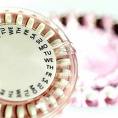Since starting the NuvaRing to manage menstrually associated migraine attacks four years ago, I’ve recommended it to numerous women who have migraine without aura. The NuvaRing is more effective than birth control pills because it provides a steady dose of hormones, while hormone levels still fluctuate throughout the day with the pill. But recent reports have raised questions about NuvaRing’s safety.
All hormonal birth control raises a woman’s risk of blood clots, but there is speculation that NuvaRing users are at greater risk than those who use oral contraceptives. Merck’s agreement to pay a $100 million settlement for thousands of liability lawsuits, announced on Friday, looks rather suspicious.
There are three studies that come into play when considering this risk. NPR summarizes them as:
“One funded by Merck, published in the journal Obstetrics and Gynecology in October, and another funded by the FDA, with data from Kaiser Permanente and Medicaid databases. The former found a similar risk for the ring and combined oral contraceptive pills. The latter found no difference in risk between new users of low-dose combined hormonal contraceptives and the NuvaRing or the birth control patch. (There was a higher risk found with pills that contain drospirenone, which is found in the pill Yaz.)
“But a study from Denmark, published in the British Medical Journal in May 2012, found a notably higher risk of blood clots from NuvaRing. Women using the NuvaRing were about six times more likely to get venous thrombosis than women who didn’t use any form of hormonal contraceptive. Compared to combined oral contraceptives with levonorgestrel, NuvaRing users were about twice as likely to form blood clots.”
Findings from the Danish study are not included in NuvaRing’s U.S. “label” (that’s FDA-speak for the detailed information that’s included with prescriptions). Again from NPR:
“FDA spokeswoman Andrea Fischer told Shots in an email that the agency ‘questioned the design and study population, and did not have the opportunity to independently review the original data.’
“For one thing, the study compares ‘all users,’ rather than just new users. ‘When using any hormonal contraceptive, the risk of blood clots is higher during the first few months of use,’ according to Fischer, so including both new and longtime users in the same study may make it seem like newer contraceptives are riskier, when actually new users of any method are already at a higher risk.”
The new versus all users distinction eased my mind considerably, though it still seemed kind of scary. The rest of NPR’s detailed explanation of the risks calmed me considerably. It’s too much to post here — it’s the entire second half of the long article — but take a look at Birth Control and Blood Clots: Women Still Weighing the Risk if you’re curious or concerned.
Personally, I’m going to continue using it for now. The risk just isn’t that great and I’ve already been on it for four years — if I were going to have problems with it, they probably would have shown up by now.
Still, since I’m older than 35 (the age at which women are warned to stop using hormonal birth control) and my migraines are no longer as constant or as devastating as they were when I started using the NuvaRing, I’ll probably go off it in a few months to see how I do without it. When I started hormonal birth control to manage menstrually associated migraine attacks, triptans were completely ineffective for me. Now that triptans are a viable option, they may ultimately be a better choice than hormonal birth control.
As with any medication, ask your doctor what your individual risk is given your own medical history and what your other treatment options are. With that information in mind, consider how much risk you’re OK with — a minute risk is acceptable for some women, for others any risk is a deal-breaker.

 As the frequency of my migraine episodes has reduced this year, I was finally able to tell that I always get a migraine the first and second or third day of my period. Today once again provided confirmation.
As the frequency of my migraine episodes has reduced this year, I was finally able to tell that I always get a migraine the first and second or third day of my period. Today once again provided confirmation.